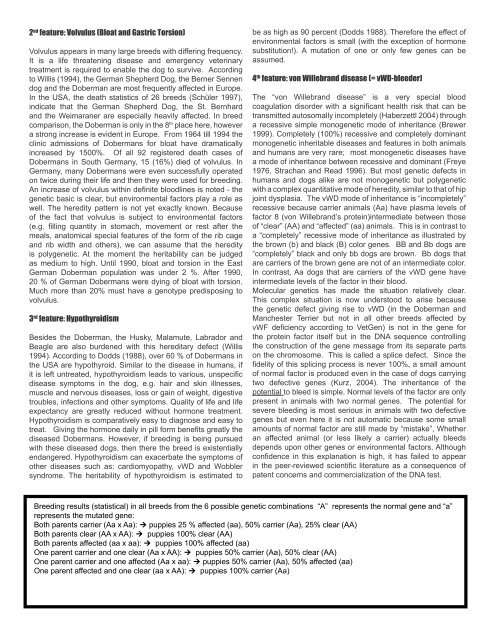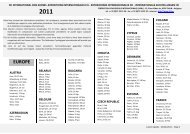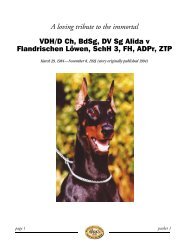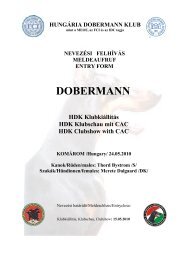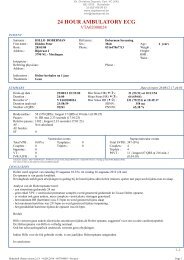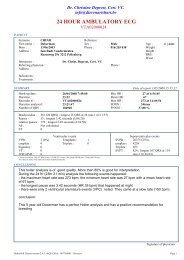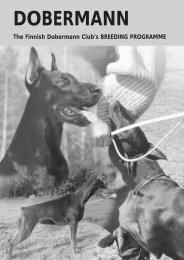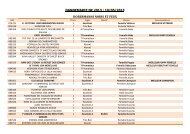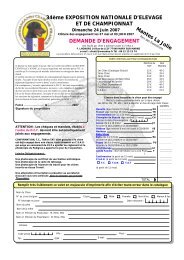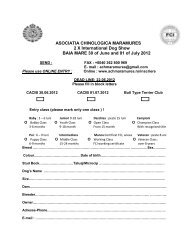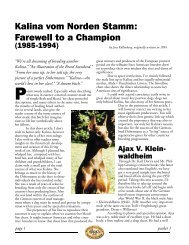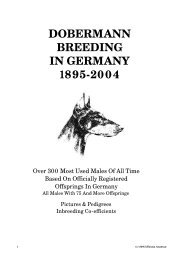2 nd feature: Volvulus (Bloat and Gastric Torsion)Volvulus appears <strong>in</strong> many large breeds with differ<strong>in</strong>g frequency.It is a life threaten<strong>in</strong>g disease and emergency veter<strong>in</strong>arytreatment is required to enable <strong>the</strong> dog to survive. Accord<strong>in</strong>gto Willis (1994), <strong>the</strong> German Shepherd Dog, <strong>the</strong> Berner Sennendog and <strong>the</strong> Doberman are most frequently affected <strong>in</strong> Europe.In <strong>the</strong> USA, <strong>the</strong> death statistics <strong>of</strong> 26 breeds (Schüler 1997),<strong>in</strong>dicate that <strong>the</strong> German Shepherd Dog, <strong>the</strong> St. Bernhardand <strong>the</strong> Weimaraner are especially heavily affected. In breedcomparison, <strong>the</strong> Doberman is only <strong>in</strong> <strong>the</strong> 8 th place here, howevera strong <strong>in</strong>crease is evident <strong>in</strong> Europe. From 1964 till 1994 <strong>the</strong>cl<strong>in</strong>ic admissions <strong>of</strong> Dobermans for bloat have dramatically<strong>in</strong>creased by 1500%. Of all 92 registered death cases <strong>of</strong>Dobermans <strong>in</strong> South Germany, 15 (16%) died <strong>of</strong> volvulus. InGermany, many Dobermans were even successfully operatedon twice dur<strong>in</strong>g <strong>the</strong>ir life and <strong>the</strong>n <strong>the</strong>y were used for breed<strong>in</strong>g.An <strong>in</strong>crease <strong>of</strong> volvulus with<strong>in</strong> def<strong>in</strong>ite bloodl<strong>in</strong>es is noted - <strong>the</strong>genetic basic is clear, but environmental factors play a role aswell. The heredity pattern is not yet exactly known. Because<strong>of</strong> <strong>the</strong> fact that volvulus is subject to environmental factors(e.g. fill<strong>in</strong>g quantity <strong>in</strong> stomach, movement or rest after <strong>the</strong>meals, anatomical special features <strong>of</strong> <strong>the</strong> form <strong>of</strong> <strong>the</strong> rib cageand rib width and o<strong>the</strong>rs), we can assume that <strong>the</strong> heredityis polygenetic. At <strong>the</strong> moment <strong>the</strong> heritability can be judgedas medium to high. Until 1990, bloat and torsion <strong>in</strong> <strong>the</strong> EastGerman Doberman population was under 2 %. After 1990,20 % <strong>of</strong> German Dobermans were dy<strong>in</strong>g <strong>of</strong> bloat with torsion.Much more than 20% must have a genotype predispos<strong>in</strong>g tovolvulus.3 rd feature: HypothyroidismBesides <strong>the</strong> Doberman, <strong>the</strong> Husky, Malamute, Labrador andBeagle are also burdened with this hereditary defect (Willis1994). Accord<strong>in</strong>g to Dodds (1988), over 60 % <strong>of</strong> Dobermans <strong>in</strong><strong>the</strong> USA are hypothyroid. Similar to <strong>the</strong> disease <strong>in</strong> humans, ifit is left untreated, hypothyroidism leads to various, unspecificdisease symptoms <strong>in</strong> <strong>the</strong> dog, e.g. hair and sk<strong>in</strong> illnesses,muscle and nervous diseases, loss or ga<strong>in</strong> <strong>of</strong> weight, digestivetroubles, <strong>in</strong>fections and o<strong>the</strong>r symptoms. Quality <strong>of</strong> life and lifeexpectancy are greatly reduced without hormone treatment.Hypothyroidism is comparatively easy to diagnose and easy totreat. Giv<strong>in</strong>g <strong>the</strong> hormone daily <strong>in</strong> pill form benefits greatly <strong>the</strong>diseased Dobermans. However, if breed<strong>in</strong>g is be<strong>in</strong>g pursuedwith <strong>the</strong>se diseased dogs, <strong>the</strong>n <strong>the</strong>re <strong>the</strong> breed is existentiallyendangered. Hypothyroidism can exacerbate <strong>the</strong> symptoms <strong>of</strong>o<strong>the</strong>r diseases such as: cardiomyopathy, vWD and Wobblersyndrome. The heritability <strong>of</strong> hypothyroidism is estimated tobe as high as 90 percent (Dodds 1988). Therefore <strong>the</strong> effect <strong>of</strong>environmental factors is small (with <strong>the</strong> exception <strong>of</strong> hormonesubstitution!). A mutation <strong>of</strong> one or only few genes can beassumed.4 th feature: von Willebrand disease (= vWD-bleeder)The “von Willebrand disease” is a very special bloodcoagulation disorder with a significant health risk that can betransmitted autosomally <strong>in</strong>completely (Haberzettl 2004) througha recessive simple monogenetic mode <strong>of</strong> <strong>in</strong>heritance (Brewer1999). Completely (100%) recessive and completely dom<strong>in</strong>antmonogenetic <strong>in</strong>heritable diseases and features <strong>in</strong> both animalsand humans are very rare; most monogenetic diseases havea mode <strong>of</strong> <strong>in</strong>heritance between recessive and dom<strong>in</strong>ant (Freye1976, Strachan and Read 1996). But most genetic defects <strong>in</strong>humans and dogs alike are not monogenetic but polygeneticwith a complex quantitative mode <strong>of</strong> heredity, similar to that <strong>of</strong> hipjo<strong>in</strong>t dysplasia. The vWD mode <strong>of</strong> <strong>in</strong>heritance is “<strong>in</strong>completely”recessive because carrier animals (Aa) have plasma levels <strong>of</strong>factor 8 (von Willebrand’s prote<strong>in</strong>)<strong>in</strong>termediate between those<strong>of</strong> “clear” (AA) and “affected” (aa) animals. This is <strong>in</strong> contrast toa “completely” recessive mode <strong>of</strong> <strong>in</strong>heritance as illustrated by<strong>the</strong> brown (b) and black (B) color genes. BB and Bb dogs are“completely” black and only bb dogs are brown. Bb dogs thatare carriers <strong>of</strong> <strong>the</strong> brown gene are not <strong>of</strong> an <strong>in</strong>termediate color.In contrast, Aa dogs that are carriers <strong>of</strong> <strong>the</strong> vWD gene have<strong>in</strong>termediate levels <strong>of</strong> <strong>the</strong> factor <strong>in</strong> <strong>the</strong>ir blood.Molecular genetics has made <strong>the</strong> situation relatively clear.This complex situation is now understood to arise because<strong>the</strong> genetic defect giv<strong>in</strong>g rise to vWD (<strong>in</strong> <strong>the</strong> Doberman andManchester Terrier but not <strong>in</strong> all o<strong>the</strong>r breeds affected byvWF deficiency accord<strong>in</strong>g to VetGen) is not <strong>in</strong> <strong>the</strong> gene for<strong>the</strong> prote<strong>in</strong> factor itself but <strong>in</strong> <strong>the</strong> DNA sequence controll<strong>in</strong>g<strong>the</strong> construction <strong>of</strong> <strong>the</strong> gene message from its separate partson <strong>the</strong> chromosome. This is called a splice defect. S<strong>in</strong>ce <strong>the</strong>fidelity <strong>of</strong> this splic<strong>in</strong>g process is never 100%, a small amount<strong>of</strong> normal factor is produced even <strong>in</strong> <strong>the</strong> case <strong>of</strong> dogs carry<strong>in</strong>gtwo defective genes (Kurz, 2004). The <strong>in</strong>heritance <strong>of</strong> <strong>the</strong>potential to bleed is simple. Normal levels <strong>of</strong> <strong>the</strong> factor are onlypresent <strong>in</strong> animals with two normal genes. The potential forsevere bleed<strong>in</strong>g is most serious <strong>in</strong> animals with two defectivegenes but even here it is not automatic because some smallamounts <strong>of</strong> normal factor are still made by “mistake”, Whe<strong>the</strong>ran affected animal (or less likely a carrier) actually bleedsdepends upon o<strong>the</strong>r genes or environmental factors. Althoughconfidence <strong>in</strong> this explanation is high, it has failed to appear<strong>in</strong> <strong>the</strong> peer-reviewed scientific literature as a consequence <strong>of</strong>patent concerns and commercialization <strong>of</strong> <strong>the</strong> DNA test.Breed<strong>in</strong>g results (statistical) <strong>in</strong> all breeds from <strong>the</strong> 6 possible genetic comb<strong>in</strong>ations “A” represents <strong>the</strong> normal gene and “a”represents <strong>the</strong> mutated gene:Both parents carrier (Aa x Aa): Ú puppies 25 % affected (aa), 50% carrier (Aa), 25% clear (AA)Both parents clear (AA x AA): Ú puppies 100% clear (AA)Both parents affected (aa x aa): Ú puppies 100% affected (aa)One parent carrier and one clear (Aa x AA): Ú puppies 50% carrier (Aa), 50% clear (AA)One parent carrier and one affected (Aa x aa): Ú puppies 50% carrier (Aa), 50% affected (aa)One parent affected and one clear (aa x AA): Ú puppies 100% carrier (Aa)
The vWD gene frequency <strong>in</strong> <strong>the</strong> American Doberman populationis very high: approximately 30% are homozygote affected,50% are carriers (heterozygote vWD, leav<strong>in</strong>g only 20% <strong>of</strong>dogs completely clear <strong>in</strong> phenotype and homozygote free <strong>of</strong>vWD genes <strong>in</strong> genotype (Kurz 2004). Probably <strong>the</strong> EuropeanDoberman is still only lightly burdened with vWD genes at <strong>the</strong>moment but exact figures do not exist. Fur<strong>the</strong>r <strong>in</strong>crease can beexpected also <strong>in</strong> <strong>the</strong> European Doberman because <strong>the</strong> breedershave taken only limited actions towards limit<strong>in</strong>g <strong>the</strong> damage.The extensive North American experience could be helpful<strong>in</strong> Europe. The vWD is found <strong>in</strong> 57 o<strong>the</strong>r breeds <strong>of</strong> purebreddogs: German shepherd dog, Corgi, Sheltie, Golden Retriever,Manchester terrier, poodles and many o<strong>the</strong>r breeds (Willis 1992,Schueler 1997), but <strong>the</strong> gene frequencies are lower than <strong>in</strong> <strong>the</strong>Doberman. For several o<strong>the</strong>r breeds, <strong>the</strong> homozygote-affecteddogs are subject to potentially lethal episodes <strong>of</strong> external and<strong>in</strong>ternal bleed<strong>in</strong>g that can occur any time and must be treated bya veter<strong>in</strong>arian. But fortunately homozygote Doberman bleederscan still produce a small amount (5-10%) <strong>of</strong> normal factor (Kurz2004) provid<strong>in</strong>g some protection aga<strong>in</strong>st uncontrolled bleed<strong>in</strong>gand mak<strong>in</strong>g <strong>the</strong> disease milder for affected Dobermans.The symptoms (phenotypes) shown by affected and carrierDobermans have such great variability because <strong>the</strong> actual vWFlevels <strong>in</strong> both affected and carrier can vary widely <strong>in</strong> differentdogs and also <strong>in</strong> <strong>the</strong> same dog at various times <strong>in</strong> his life. Thesegreat phenotypical variations must arise from <strong>in</strong>teractions <strong>of</strong> <strong>the</strong>vWD gene with o<strong>the</strong>r (unknown) genes and to environmentalfactors <strong>in</strong> <strong>the</strong> <strong>in</strong>dividual Doberman (stress, high <strong>in</strong>breed<strong>in</strong>g,hypothyroidism, o<strong>the</strong>r diseases or factors). There is also <strong>the</strong>possibility that we have more than one deleterious mutation <strong>in</strong><strong>the</strong> vW genes or different alleles at <strong>the</strong> same gene locus, sothat <strong>the</strong> prote<strong>in</strong>s <strong>in</strong> phenotypes <strong>of</strong> different affected and carrierDobermans are different. Research is cont<strong>in</strong>u<strong>in</strong>g (CornellVeter<strong>in</strong>ary School).In genotype, both carriers and affected dogs differ only <strong>in</strong> <strong>the</strong>degree <strong>of</strong> penetrance <strong>of</strong> <strong>the</strong> defective gene (Dodds 1988).That is, a carrier although outwardly a healthy Doberman is notvigorous, <strong>in</strong> <strong>the</strong> sense that it does not have <strong>the</strong> same reservesas a normal dog to withstand environmental stress. If a vWDcarrier becomes hypothyroid, it may be subject to bleed<strong>in</strong>gepisodes unless placed on thyroid supplement.The exact nature <strong>of</strong> breed<strong>in</strong>g practice (<strong>in</strong>breed<strong>in</strong>g oroutcross<strong>in</strong>g) can have a great <strong>in</strong>fluence on vitality. S<strong>in</strong>ce 1970breed<strong>in</strong>g <strong>of</strong> affected animals has slowed <strong>in</strong> <strong>the</strong> US but it is<strong>in</strong>creas<strong>in</strong>g <strong>in</strong> <strong>the</strong> Ne<strong>the</strong>rlands, Italy, Norway, and Hungary. InGermany, <strong>the</strong>re is almost complete <strong>in</strong>attention to this problemeven by <strong>the</strong> most prestigious breeders; <strong>the</strong> vWD status <strong>of</strong> <strong>the</strong>European population should be checked most urgently.The new American DNA test is an excellent, simple methodthat <strong>the</strong> European Doberman breeder could use to prevent an<strong>in</strong>crease from <strong>the</strong> low gene frequency <strong>in</strong> <strong>the</strong> European Dobermanpopulation to <strong>the</strong> high gene frequency <strong>in</strong> North America. Theold prote<strong>in</strong>-based method was completely unreliable for carrierdetection because <strong>of</strong> <strong>the</strong> great <strong>in</strong>dividual variation <strong>in</strong> phenotype(<strong>the</strong> plasma levels <strong>of</strong> normal VWD-prote<strong>in</strong>.) The vWD DNA testis valid lifelong for every dog. The DNA test report is given as“clear or “carrier” or “affected”. This one result for one dog isdef<strong>in</strong>itive and f<strong>in</strong>al. Retest<strong>in</strong>g is po<strong>in</strong>tless, because <strong>the</strong> resultwill always be <strong>the</strong> same for a given animal (Brewer 1999).After identify<strong>in</strong>g all carriers <strong>in</strong> <strong>the</strong> breed<strong>in</strong>g population Americanbreeders could quickly reduce <strong>the</strong> disease gene frequency.First <strong>the</strong> simple monogenetic mode <strong>of</strong> heredity and second<strong>the</strong> DNA test give <strong>the</strong> American breeder a very good chanceto elim<strong>in</strong>ate VWD disease <strong>in</strong> future generations. In fact, this isoccurr<strong>in</strong>g (Kurz, 2004).5 th feature: Wobbler syndrome (paralysis)The Wobbler syndrome is a hereditary degenerative disease<strong>of</strong> <strong>the</strong> neck sp<strong>in</strong>al column, occurr<strong>in</strong>g most commonly <strong>in</strong> middleage. Deformed <strong>in</strong>tervertebral discs and sp<strong>in</strong>e bodies constrict<strong>the</strong> nerve tissues <strong>in</strong> <strong>the</strong> sp<strong>in</strong>al cord, so that pa<strong>in</strong>, movementdisorders and paralysis occur. Surgery is <strong>the</strong> only successfultreatment. Besides <strong>the</strong> Doberman, such cases are alsopresent <strong>in</strong> <strong>the</strong> German Shepherd Dog, Basset and Barsoi.Accord<strong>in</strong>g to Schüler (1997), <strong>the</strong> American Doberman has ahigher occurrence than <strong>the</strong> European. However, exact figuresare known nei<strong>the</strong>r for North America nor for Europe. Theexact heredity <strong>of</strong> <strong>the</strong> syndrome is not clear, primarily because<strong>the</strong>re is far too little cooperation <strong>of</strong> <strong>the</strong> breeder clubs with<strong>the</strong> Universities. Van der Zwan (1987) supposes a polygeneheredity symptom with probable high heritability.6th Feature: Degenerative eye diseases (PHTVL/PHPV)Impaired vision up to full loss <strong>of</strong> <strong>the</strong> sight is <strong>the</strong> result <strong>of</strong> geneticconditioned degeneration <strong>of</strong> <strong>the</strong> eye and occurs <strong>in</strong> severalbreeds with different frequently. Accord<strong>in</strong>g to Willis (1994)<strong>the</strong> Staffordshire Bull Terrier, Basenji and <strong>the</strong> Doberman areaffected most strongly by PHTVL/PHPV. This is a disorder <strong>of</strong> afetal development <strong>of</strong> <strong>the</strong> eye that results <strong>in</strong> large and small spotsand turbidity on <strong>the</strong> eye; <strong>the</strong> spots are caused by <strong>the</strong> persistent(that would normally disappear) embryonic membranes andblood vessels.It is assumed to be an autosomal <strong>in</strong>completely dom<strong>in</strong>an<strong>the</strong>redity (Schüler 1997) and a high heritability should beexpected. The abbreviations mean: PHTVL persistent hyperplasticTunica vascularis lentis, PHPV persistent hyper-plasticprimary Vitreum.While this disease is presently very rare <strong>in</strong> <strong>the</strong> AmericanDoberman, it can be expected to <strong>in</strong>crease with <strong>the</strong> arrival <strong>of</strong>European imports unless vigilance is practiced. Dogs wi<strong>the</strong>ven mild degrees <strong>of</strong> this disorder should not be bred as aconsequence <strong>of</strong> <strong>the</strong> <strong>in</strong>complete dom<strong>in</strong>ant heredity; Dogs withmild degrees <strong>of</strong> this defect can produce bl<strong>in</strong>d whelps.Conclusions for all breedsThrough <strong>the</strong> negative example <strong>of</strong> <strong>the</strong> Doberman <strong>in</strong> Germany,Europe and <strong>the</strong> USA, <strong>the</strong> reader can see that <strong>in</strong> less than20 years <strong>the</strong> Doberman changed from a very healthy, vitaland long-lived dog breed to a breed that is susceptible todisease with an average life-expectancy less than 7 years(West Germany 1989). The genetic degeneration <strong>of</strong> <strong>the</strong>whole population worldwide has progressed as a result <strong>of</strong>breed<strong>in</strong>g with sick animals (phenotype and genotype). Theaverage life-expectancy <strong>of</strong> over 5 years can be reached formany <strong>in</strong>dividual dogs only with great f<strong>in</strong>ancial veter<strong>in</strong>arianexpenditures (e.g. 1 pill <strong>of</strong> thyroid gland hormone daily, heart


